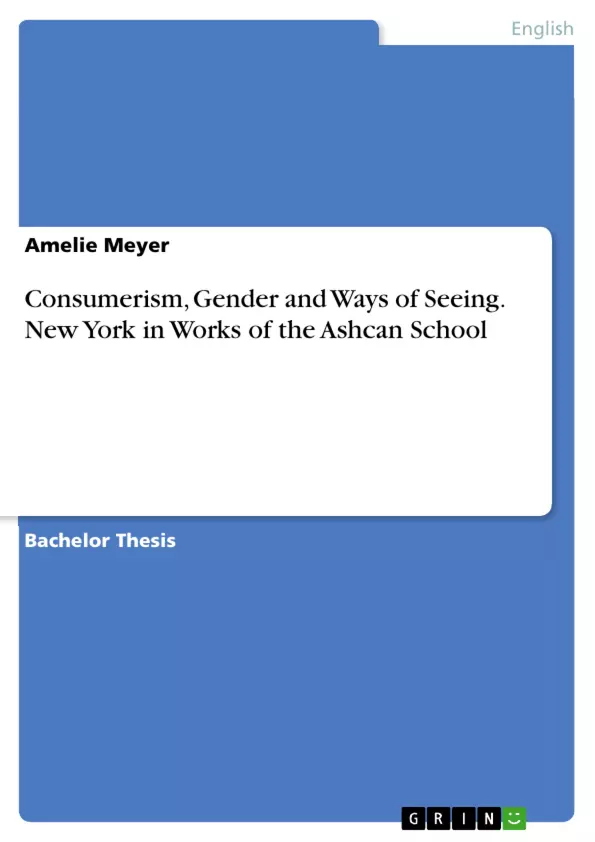At the turn of the nineteenth century, the city of New York underwent a tremendous change that is regarded as a complete “transformation of American culture” (Zurier). An abundance of scholarly works have been devoted to those developments that were of a geographic, economic or social nature. An equally great focus has been on the rise of a new kind of consumer culture which, according to Tottis, rang in an “age of Amusement” which included the advent of the department store, popular entertainment and advertisement (Zurier). Recent scholars, among them Rebecca Zurier, have concentrated on the role of public display within this consumer culture. People were not only there “to buy, but merely to ‘see’ the things” they desired to purchase (Bowlby, “Looking”). The display and constant “visuality” of the outer look of the city on the one hand and the mutual gazing of city people on the other hand caused the need for a “new skill of urban viewing” people had yet to learn (Manthorne). Thus, new ways of seeing developed.
Within this context of a heavily pictorial and visual consumer culture, scholars have examined the works of the Ashcan School, a group of artists known for their ‘common’ city depictions. Up to the present, few scholars did not concentrate on the Ashcan artists’ portrayal of poor living conditions, toil and tenements. Instead, they began to analyze the consumerist scenes of the Ashcan School’s oeuvre: they contemplated the issues of public display, its effects on New York’s citizen and they also scraped the surface of the gender issue within consumerism.
This bachelor thesis is intended to extent this study in order to provide a coherent picture of how consumerism, gender and new ways of seeing play together in a number of Ashcan works. The portrayals of Everett Shinn and John Sloan have been chosen for their depicted content of entertainment, shopping and urban viewing.
Inhaltsverzeichnis (Table of Contents)
- Introduction
- Turn-of-the-Century New York: Setting the course for an “Age of Amusement”
- New Ways of Seeing and the Gendering of Consumption
- The Department Store
- Popular Entertainment
- Visual Activity
- The Representation of New York Consumerism in Works of the Ashcan School
- Representations of Consumerist Display
- Everett Shinn's Window Shopping (1903)
- John Sloan's Hairdresser's Window (1907)
- John Sloan, The Show Case (1905)
- Popular Entertainment
- Everett Shinn's Theater Box (1906)
- John Sloan, Fun, One Cent (1905)
- John Sloan, Movies, Five Cents (1907)
- The Culture of Looking
- John Sloan, Sunday Afternoon in Union Square (1912)
Zielsetzung und Themenschwerpunkte (Objectives and Key Themes)
This thesis aims to examine the interplay of consumerism, gender, and new ways of seeing in works of the Ashcan School. The study focuses on how the social, geographic, and economic changes in turn-of-the-century New York led to a new kind of consumerism that heavily depended on display and public spectacle. It further investigates how these changes impacted the perception of others and oneself, particularly in the context of popular entertainment and heightened visual activity in the city.
- The emergence of a new consumer culture in turn-of-the-century New York
- The role of public display and spectacle in this consumer culture
- The impact of new ways of seeing on the perception of others and oneself
- The gendering of consumption and the role of women in this new consumer society
- The representation of consumerist scenes and their social implications in the works of the Ashcan School
Zusammenfassung der Kapitel (Chapter Summaries)
- Introduction: This chapter sets the scene by outlining the significant changes that transformed New York at the turn of the century, leading to the rise of a new consumer culture characterized by public display and visual spectacle. It also highlights the gendered aspects of this culture, focusing on the impact on women's self-perception and social roles.
- Turn-of-the-Century New York: Setting the course for an “Age of Amusement”: This chapter explores the specific conditions that shaped the consumer-oriented city of turn-of-the-century New York. It analyzes the role of demographic growth, new production processes, and the emergence of a new middle class with disposable income and leisure time in contributing to the rise of a culture focused on visual spectacle, excitement, and self-fulfillment.
- New Ways of Seeing and the Gendering of Consumption: This chapter focuses on how new ways of seeing emerged as a result of the changing social landscape in New York. It examines the role of department stores, popular entertainment, and heightened visuality in shaping these new ways of seeing and how these developments were intertwined with the gendering of consumption.
Schlüsselwörter (Keywords)
This thesis explores the keywords of consumerism, gender, visual culture, Ashcan School, public display, spectacle, popular entertainment, department stores, and turn-of-the-century New York. It examines the interplay of these concepts in the context of the emerging consumer society and its impact on the lives and perceptions of New Yorkers.
- Citar trabajo
- Amelie Meyer (Autor), 2011, Consumerism, Gender and Ways of Seeing. New York in Works of the Ashcan School, Múnich, GRIN Verlag, https://www.grin.com/document/537941



